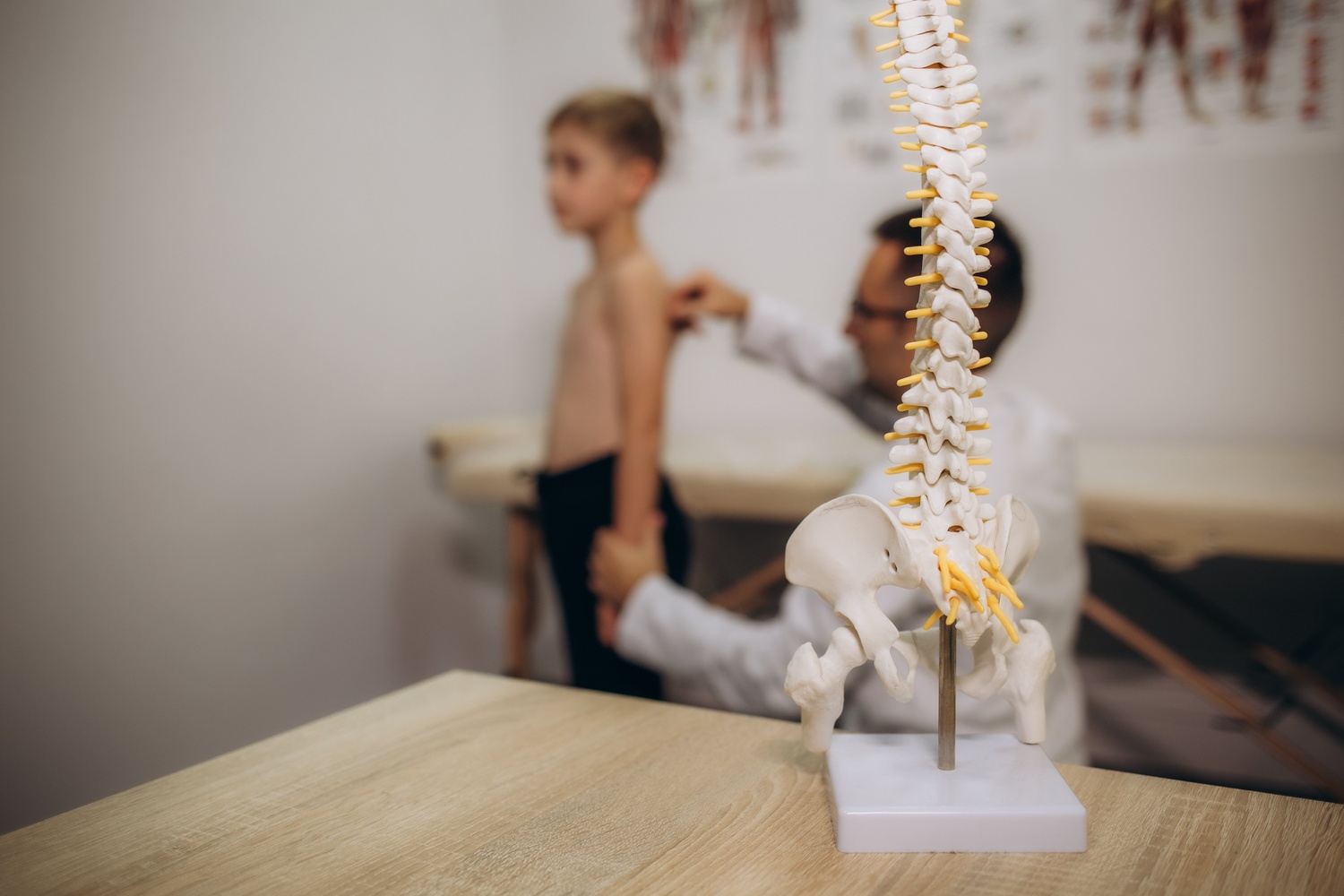Last Updated on September 24, 2025 by Nala Thorpe
Main Points:
- Watch for rounded shoulders, uneven hips, and forward head posture as early warning signs.
- Heavy or poorly fitted backpacks and long screen time often contribute to posture problems.
- Simple home checks, like the wall test or shoulder-level comparison, can reveal posture changes.
- Seek a pediatrician or specialist if pain, visible curves, or limited movement persist.
- Consistent ergonomic habits and active play help prevent posture issues from becoming long-term problems.
Good posture in childhood lays the groundwork for healthy movement and comfort as kids grow. When the spine, shoulders, and hips are aligned, muscles and joints don’t have to work harder than they should. Poor posture, on the other hand, can lead to aches, fatigue, and uneven development that may linger into adulthood if ignored.
Modern routines make posture problems more common. Hours spent on tablets or gaming consoles, carrying heavy or poorly fitted backpacks, and sitting for long stretches at school all put stress on a child’s developing body. Even activities that seem harmless, like slouching on the couch while watching shows, can reinforce bad habits over time.
Parents and caregivers who pay attention to posture early can help children avoid later complications. Noticing small signs now allows for simple adjustments in daily routines before issues harden into patterns.
What Healthy Posture Looks Like at Different Ages
Healthy posture isn’t identical for every child. In early toddlerhood, a forward-tilting belly and a slight curve in the lower back are normal because core muscles are still developing. As children move into the preschool and elementary years, the spine gradually strengthens and the back begins to look straighter. Shoulders should rest at the same height, and hips should be even when the child stands relaxed.
School-age kids typically show three gentle curves in their spine: a small inward curve at the neck, a slight outward curve at the upper back, and another inward curve at the lower back. These curves help absorb shock and support balance. A noticeable hump, sharp arch, or uneven shoulders may signal something worth checking.
Teenagers go through growth spurts that can temporarily change posture. Some may slouch because their limbs feel long and awkward or because their muscles are catching up to bone growth. Others might lean forward from carrying books or sports gear. Recognizing what’s normal at each stage makes it easier to tell the difference between a passing phase and a potential problem that could require a closer look.
What Often Triggers Posture Problems in Kids
The habits and changes that lead to posture issues usually build up quietly. These common factors explain why even healthy children can develop poor alignment:
- Extended screen time and poor sitting habits
Leaning over tablets, gaming consoles, or phones places a child’s head far forward of the shoulders. Over hours each day, this posture can train the spine and neck muscles to stay in that position even when screens are gone. - Heavy or improperly worn school bags
Carrying a backpack slung over one shoulder or loaded beyond a safe weight shifts the body’s center of gravity. It can cause uneven shoulders, sore backs, and compensating twists at the hips. Pediatric orthopedics often highlight how these repetitive stresses can influence spinal development. - Lack of physical activity or weak core muscles
A strong core supports an upright stance without strain. When children sit most of the day and rarely engage in activities that work their trunk muscles, their posture can sag simply because the muscles can’t hold alignment for long. - Growth spurts and rapid body changes
During a growth spurt, bones can lengthen faster than muscles adapt. Kids may slump or lean as their body proportions shift. This can be temporary, but it’s still a window when posture habits take root.
Seeing these influences laid out makes it easier to connect everyday routines with the posture you’re observing.
Early Signs Parents Can Notice at Home
Posture changes don’t always shout for attention. Looking for small, specific shifts in a child’s stance or comfort can give a clearer picture of what’s going on.
- Visual cues
Rounded shoulders, a head that juts forward, or hips that seem uneven when a child stands relaxed are all early indicators. Watch for one shoulder blade sticking out more than the other or a waistband sitting crooked on the hips. - Behavioral cues
A child who often complains of back or neck pain, or who seems unusually tired after sitting at a desk, may be compensating for weak support muscles or an awkward spinal position. - Clothing fit and shoe wear patterns
A wardrobe for your growing child that twists to one side or has hems that hang unevenly can point to an off-balance stance. Shoes that wear down faster on one edge also tell a story about how weight is distributed across the feet. - Differences across age groups
Younger kids might show these signs as clumsiness or awkward sitting habits, while older children and teens may report discomfort more directly. Growth spurts can mask or exaggerate these signs, making regular observation valuable.
Watch long enough and a pattern starts to emerge on its own; no need to force a verdict right away.
Practical Checks Parents Can Try at Home
Quick, simple checks can help you see posture patterns without turning it into an exam. These ideas keep things low-pressure for both you and your child:
- Wall test
Have your child stand with their back against a wall, heels a few inches away. Their head, shoulder blades, and buttocks should touch the wall naturally. If the head or lower back is far from the wall, it might hint at slouching or an exaggerated curve. - Standing straight and at shoulder level
Ask them to stand in their usual relaxed position. Look at the height of both shoulders and hips. If one side sits higher, it can signal uneven muscle use or how they’re carrying weight. - Observe during everyday activities
Posture habits show up most after school, while using a tablet, or carrying a backpack. Watch how they sit at the table or slump into the couch; those moments reveal more than a single test. - Photos or short videos
Take occasional photos from the front, side, and back (with their consent) to see gradual changes. Comparing images over weeks gives a clearer sense of trends you might otherwise miss.
Frame these checks as ‘seeing how your body feels today’ rather than a criticism. Make it brief and positive so your child stays open to small adjustments later on.
When to Seek Help
Certain signs call for more than home checks. Persistent pain, visible spinal curves that seem to worsen, or ongoing differences in shoulder or hip height signal a need to book an appointment with a pediatrician. A physical therapist or orthopedist may also be appropriate if your child’s movement appears limited or awkward during routine activities. Each of these professionals looks at posture with a trained eye and can pick up on issues parents might miss.
During an evaluation, expect a review of your child’s medical history, a physical exam, and posture or movement assessments. The clinician may watch your child walk, sit, and bend to see how muscles and joints work together. Simple tools like plumb lines, posture grids, or strength tests help them measure alignment and function without invasive procedures.
If a problem is detected, early intervention plans often involve targeted exercises, stretches, or activity changes tailored to your child’s age and condition. In some cases, short-term supports or specialist referrals come into play. Acting at this stage keeps minor posture concerns from becoming long-term issues and gives your child a practical way to build healthier movement habits.
Preventive Strategies for Healthy Posture
Daily routines shape how a child holds themselves far more than one-off reminders. Paying attention to the setup of their spaces and the rhythm of their movement can keep alignment from drifting in the first place.
- Set up an ergonomic study space
Adjust chair height so feet rest flat on the floor and knees are at a right angle. Place screens at eye level to reduce forward head tilt and slouching. - Encourage active play and core-strengthening activities
Activities like swimming, biking, or playground climbing build core and back strength. Even a few minutes of stretching before homework can help reset posture after sitting. - Guide backpack weight and fit
Keep the backpack’s weight to a manageable fraction of your child’s body weight. Use two padded straps over both shoulders and tighten them so the pack sits high on the back rather than sagging low. - Model good posture yourself
Children copy what they see. Sitting upright at meals or keeping shoulders back during screen time sends a stronger message than constant reminders.
Integrating these habits gradually helps children form routines that support healthy alignment without making it feel like a chore.
Conclusion and Takeaway Tips
Keeping an eye on posture doesn’t require special training, only steady awareness. Rounded shoulders, uneven hips, head-forward stance, or frequent complaints of back and neck discomfort can hint at developing issues. Clothing that hangs crookedly or shoes that wear unevenly offer subtle clues, too.
Simple steps at home (checking posture against a wall, adjusting desk and screen height, balancing backpack weight, and encouraging active play) add up over time. Each small action supports stronger muscles and better alignment.
Paying proactive attention rather than reacting to pain lets you step in early without turning posture into a point of anxiety. Approached calmly and consistently, these habits give children a better chance at comfortable movement and fewer problems as they grow.




